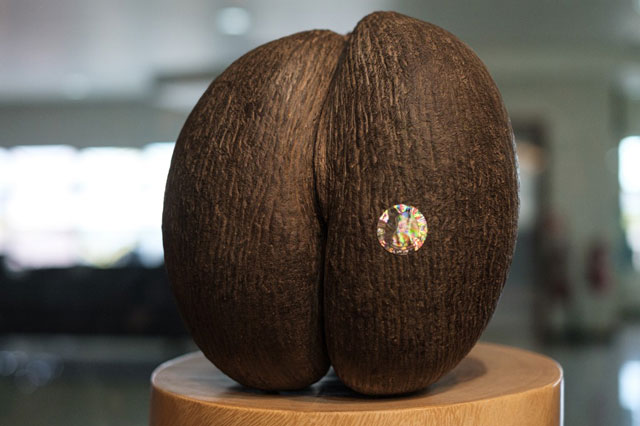
Au Cap, Seychelles | AFP | It is the world’s largest seed, and with a shape suggestive of a woman’s hips and myths of love-making powers, the coco de mer is an icon of the Seychelles.
With a 10-kilogramme (22-pound) coconut wedged between his feet, experienced nut cutter Christophe Bristol uses a mallet and wood chisel to extract the precious kernel from the shell in a warehouse on the Indian Ocean archipelago.
Every bit is valuable.
“The kernel is sold at a very high price in China,” said Bristol, hammering at the curvaceous contours of the nut, which features on the Seychelles’ coat of arms.
But on the islands, the “double coconut” is more commonly called in French “coco fesse”, or the “coconut buttock”.
For centuries, myths and mysteries grew up around the nut — and it was exploited to the brink of extinction.
The impressive coconut palms grows only on two Seychelles islands, Praslin and Curieuse.
“People have a superstition; they grind it and put it in alcohol like whisky, then they drink it and it gives them strength,” Bristol said. “That’s the myth.”
In the nut warehouse in Au Cap on Mahe, the main island of Seychelles, Bristol cuts through the outer shell of the seed.
Today, strict government rules mean that less than 2,000 nuts are harvested each year.
– Red List –
Preparing the nut takes time and skill.
“To open and empty a coco de mer takes around 20 minutes,” said Bristol, explaining how the extreme hardness of the outer shell is a tough nut to crack. “It’s much more difficult than a regular coconut.”
To prepare it, the shell is cut in half along the groove giving it its unique shape, and then emptied of the pulpy kernel.
“Nowadays, we cut the coco de mer in two with a powerful electric saw — but before, we did it with a handsaw, and (the shell) is so hard that it could take up to half an hour” just to open it, he said.
“It is harder than most types of wood.”
The halves are then glued back together to be sold in souvenir shops, for prices ranging from 3,000 to 4,000 Seychellois rupees ($220-295, 200-265 euros), accompanied by a certificate.
The kernel can fetch up to $100 per kilo (90 euros), according to the Minister of Tourism Didier Dogley.
The coco de mer has been coveted for centuries.
Originally, nuts were found drifting in the open sea, or washed up on beaches in the Indian Ocean. Having never seen it grow on land, sailors thought it came from trees rooted in the seabed — hence its name in French, coco de mer, or sea coconuts.
It was not until the 17th century that sailors found the trees where the unique nut actually grows.
For a while demand dropped — not least because conventional coconuts have a sweeter taste.
But the coco de mer became popular again after tourism took off following the independence of Seychelles in 1976.
So much so, that the Seychelles authorities decided in 1978 to control the trade.
But the restrictions were ignored by nut poachers, putting the coconut palm in danger.
Since 2011, it has been put on the “red list” of the International Union for Conservation of Nature (IUCN).
– Nut buttock brandy –
The government finally succeeded in putting an end to poaching by tightening the surveillance of the areas where they grow, like the Vallee de Mai, a UNESCO world heritage site, and enforcing regulation of the trade.
“The coco de mer issue, I always compare it to what is happening with the elephants in Africa,” said Tourism Minister Dogley.
Only four companies have a license to process and export the pulp, including Island Scent, where Bristol works.
Each nut is carefully numbered and weighed before cutting.
Bristol then separately measures the weight of the extracted pulp and records it in a notebook, checked later by the authorities.
He then cuts the large white pieces into very thin slices, which will be dried, packaged, exported and ultimately sold in Asia.
For the Seychelles, which relies on importing some 90 percent of its goods, the nut is a rare resource that is unique to the islands.
Wishing to capitalise on that, the authorities prohibit the export of non-emptied seed — which could be planted elsewhere — and encourage the processing of the pulp.
“It’s about optimising the resource,” said Dogley.
Liqueur, gourmet dishes, cosmetics — the coco de mer is transformed in multiple ways.
The latest addition is an “island brandy” which was launched late last year and is sold for several hundred dollars per bottle.
 The Independent Uganda: You get the Truth we Pay the Price
The Independent Uganda: You get the Truth we Pay the Price



